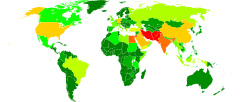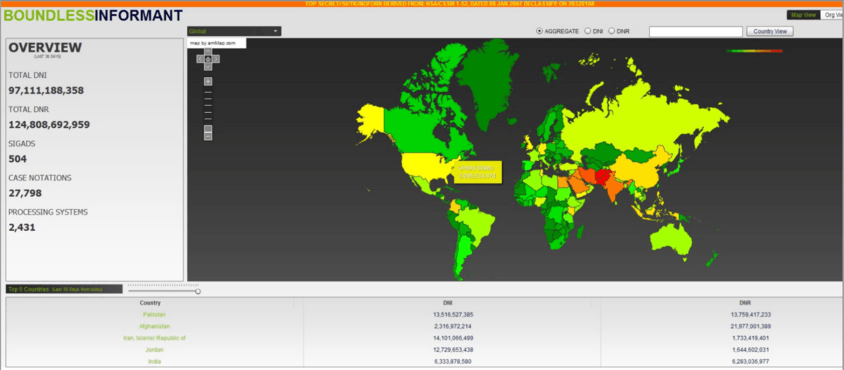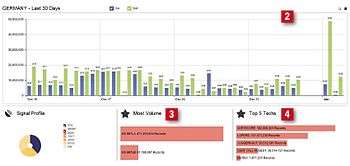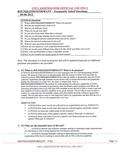Boundless Informant
Boundless Informant (stylized as BOUNDLESSINFORMANT) is a big data analysis and data visualization tool used by the United States National Security Agency (NSA). It gives NSA managers summaries of the NSA's worldwide data collection activities by counting metadata.[1] The existence of this tool was disclosed by documents leaked by Edward Snowden, who worked at the NSA for the defense contractor Booz Allen Hamilton.[2] Those disclosed documents were in a direct contradiction to the NSA's assurance to United States Congress that it does not collect any type of data on millions of Americans.[3]
 National Security Agency surveillance |
|---|
 |
|
Programs
|
|
Institutions
|
|
Lawsuits
|
|
Whistleblowers
|
|
Publication
|
|
Related
|
History
Intelligence gathered by the United States government inside the United States or specifically targeting US citizens is legally required to be gathered in compliance with the Foreign Intelligence Surveillance Act of 1978 (FISA) and under the authority of the Foreign Intelligence Surveillance Court (FISA court).[4][5][6]
NSA global data mining projects have existed for decades, but recent programs of intelligence gathering and analysis that include data gathered from inside the United States such as PRISM were enabled by changes to US surveillance law introduced under President Bush and renewed under President Obama in December 2012.[7]
Boundless Informant was first publicly revealed on June 8, 2013, after classified documents about the program were leaked to The Guardian.[1][8] This report contained a Top Secret heat map produced by the Boundless Informant program summarizing data records from 504 separate DNR and DNI collection sources or SIGADs. In the map, countries that are under surveillance are assigned a color from green to red (which does not correspond to intensity of surveillance).[9][10]

As this map shows that almost 3 billion data elements from inside the United States were captured by the NSA over a 30-day period ending in March 2013, Snowden stated that this tool was collecting more information on Americans located within the United States than on Russians in Russia.[11] Snowden stated that he raised concerns with two superiors in the Hawaii regional base of the NSA Threat Operations Center and two superiors in the Technology Directorate of the NSA beginning in October 2012, and therefore that counted as using internal dissent channels in the NSA.[11]
Snowden added that coworkers often were "astonished to learn" about this detail and did not wish to know any more about the program, and that until April 2012 he often asked these colleagues "What do you think the public would do if this was on the front page?"[11] Vanee Vines, an NSA spokesperson, stated that "After extensive investigation, including interviews with his former NSA supervisors and co-workers, we have not found any evidence to support Mr. Snowden's contention that he brought these matters to anyone's attention."[11]
The first publication about Boundless Informant was followed by screenshots from this program showing charts with details about the data that NSA allegedly collected from several European countries between December 10, 2012 and January 8, 2013. These charts were published by a major news outlet from each of these countries:

- July 29, 2013: Germany: a big chart about this country, showing more than 552 million telephony and internet data, alongside four smaller charts about The Netherlands, France, Spain and Italy were published by the magazine Der Spiegel.[12]
- October 20, 2013: France: a chart showing almost 70 million telephony metadata was published by the newspaper Le Monde.
- October 28, 2013: Spain: a chart showing 60 million telephony metadata was published by the newspaper El Mundo.[13]
- November 19, 2013: Norway: a chart showing 33 million telephony metadata was published by the tabloid paper Dagbladet.[14]
- December 6, 2013: Italy: a chart showing almost 46 million telephony metadata was published by the tabloid paper L'Espresso.[15]
- February 8, 2014: The Netherlands: a chart showing 1.8 million telephony metadata was published by the newspaper NRC Handelsblad.[16]
Initially, these media wrote that the BoundlessInformant charts showed how many phone calls the NSA intercepted from a particular country. A first correction of this interpretation is that the program doesn't count the content of phone calls, but only the metadata thereof (see below).
A second correction is about by whom and where these data were collected. On August 5, a week after the publication of a chart from BoundlessInformant in Germany, the German intelligence agency (BND) said that they collected these data from foreign communications, related to military operations abroad.[17][18] A similar statement was made by the Norwegian Intelligence Service, after a chart about Norway was published on November 19.[19] On February 4, 2014, the Dutch government revealed that the 1.8 million metadata in the chart about the Netherlands were not collected by NSA, but instead by the Dutch Military Intelligence and Security Service (MIVD), also to support military operations, which almost led to the resignation of the Dutch interior minister.[20]
On October 29, 2013, NSA-director Keith B. Alexander declared that accusations in French, Spanish and Italian media about NSA intercepting millions of phone calls from these countries are "completely false". He added that "This is not information that we collected on European citizens. It represents information that we and our NATO allies have collected in defense of our countries and in support of military operations."[21]
Technology
Although the initial reports in European media stated that the various charts presented the numbers of phone calls intercepted by NSA, a powerpoint presentation and a FAQ document published by The Guardian[22] say that BoundlessInformant is counting and analysing DNI (internet) and DNR (telephony) metadata records passing through the NSA's signals intelligence systems, and are therefore not showing how much content of internet and telephone communications is intercepted.[23]
Data analyzed by Boundless Informant includes electronic surveillance program records and telephone call metadata records stored in an NSA data archive called GM-PLACE. It does not include FISA data, according to the FAQ memo. PRISM, a government codename for a collection effort known officially as US-984XN, which was revealed at the same time as Boundless Informant, is one source of DNR data.[9][10]
According to published slides, Boundless Informant leverages Free and Open Source Software—and is therefore "available to all NSA developers"—and corporate services hosted in the cloud. The tool uses HDFS, MapReduce, and Accumulo (formerly Cloudbase)[24] for data processing.[25]
Media related to Boundless Informant
 Boundless Informant Presentation Cover page
Boundless Informant Presentation Cover page Boundless Informant Presentation Slide 2
Boundless Informant Presentation Slide 2 Boundless Informant Presentation Slide 3
Boundless Informant Presentation Slide 3 Boundless Informant Presentation Slide 4
Boundless Informant Presentation Slide 4 Boundless Informant FAQ
Boundless Informant FAQ Spain and Italy, last 30 days
Spain and Italy, last 30 days Netherlands and France, Last 30 days
Netherlands and France, Last 30 days
See also
- List of government surveillance projects
- NSA warrantless surveillance (2001–07)
- Stellar Wind
References
- Glenn Greenwald and Ewen MacAskill (June 8, 2013). "Boundless Informant: the NSA's secret tool to track global surveillance data". The Guardian. London. Retrieved June 12, 2013.
- Greenwald, Glenn; MacAskill, Ewen; Poitras, Laura (June 9, 2013). "Edward Snowden: the whistleblower behind revelations of NSA surveillance". The Guardian. London. Retrieved June 9, 2013.
- "Here's The NSA's Supposedly Non-Existent Tool To Track Global Metadata". Gawker. June 9, 2013. Archived from the original on March 20, 2014. Retrieved March 20, 2014.
- Dean, John W. George W. Bush as the New Richard M. Nixon: Both Wiretapped Illegally, and Impeachable; Both Claimed That a President May Violate Congress' Laws to Protect National Security, FindLaw, December 30, 2005
- The Impeachment of George W. Bush by Elizabeth Holtzman, The Nation, January 11, 2006
- Adopted By The House Of Delegates (Archive), American Bar Association, February 13, 2006
- Greenwald, Glenn (June 6, 2013). "NSA taps in to internet giants' systems to mine user data, secret files reveal". The Guardian. London. Retrieved June 6, 2013.
- "Boundless Informant | World news". The Guardian. London. June 8, 2013. Retrieved June 9, 2013.
- "Boundless Informant NSA data-mining tool – four key slides". The Guardian. London. June 8, 2013. Retrieved June 9, 2013.
- "Government: 11 things you need to know about u.s. domestic spying". The Blaze, Inc. June 7, 2013.
- Gellman, Barton. "Edward Snowden, after months of NSA revelations, says his mission’s accomplished." The Washington Post. December 23, 2013. Retrieved on February 7, 2014.
- Daten aus Deutschland, August 5, 2013
- Glenn Greenwald & German Aranda, La NSA espió 60 millones de llamadas en España en sólo un mes, October 28, 2013
- Glenn Greenwald & Arne Halvorsen, USA overvåket 33 millioner norske mobilsamtaler, November 19, 2013
- Glenn Greenwald & Stefania Maurizi, Da qui ci spiano gli americani, December 6, 2013.
- Top Level Telecommunications, BOUNDLESSINFORMANT: metadata collection by Dutch MIVD instead of NSA, February 8, 2014
- Der Spiegel, Mass Data: Transfers from Germany Aid US Surveillance, August 5, 2013
- Marcel Rosenbach & Holger Stark, Der NSA Komplex, Deutsche Verlags-Anstalt, München 2014, p. 235 and 326.
- RT.com, Norway admits it carried out phone surveillance for NSA, November 19, 2013.
- Top Level Telecommunications, Dutch government tried to hide the truth about metadata collection, February 17, 2014
- Reuters.com, NSA chief defends agency amid U.S. spy rift with Europe, October 29, 2013
- "Boundless Informant: NSA explainer – full document text". The Guardian. London. June 8, 2013. Retrieved June 12, 2013.
- Top Level Telecommunications, BOUNDLESSINFORMANT only shows metadata, October 22, 2013.
- "NSA Mimics Google, Pisses Off Senate, Cade Metz". Wired. July 17, 2012.
- "Boundless Informant slides". Documentcloud.org. Retrieved June 9, 2013.
External links
| Wikimedia Commons has media related to Boundless Informant. |